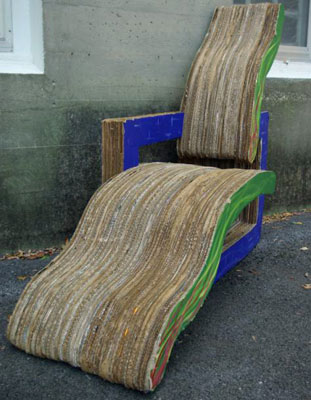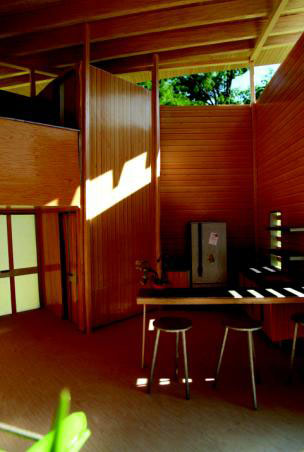An Interview with Amy Elizabeth Wiggins (original) (raw)
Feature Mon Dec 08 2008
Amy Elizabeth Wiggins is a designer and graduate student at the School of the Art Institute. She took some time out from creating some of the beautiful things you see below to talk with us about design and the real purpose of a beautiful object.
Can you tell us a little bit about what you do? What is a "designed object?"
Right now I am getting my Masters of Design in Designed Objects (MDDO) at the School of the Art Institute. My courses cover the ideation, fabrication, and theory behind creating things. This is significantly different from industrial design programs in that I'm learning more theory rather than specifically designing things like refrigerator and toasters. Not that there's anything wrong with industrial design. I'm really thankful for industrial design programs every day when I get food out of my refrigerator, but I'm really interested in the interaction between design and culture. How they both influence each other. For instance, right now I'm working on a design that rather than being functional, comments on a social condition. It's a helmet that helps to facilitate the blocking out of distractions while people are using electronic products. Much like horse blinders, the helmet works to increase the user's self-absorption and obstruct the perception of reality.
How did you become interested in design?
I just always have been interested in design. My mom still has a 3D paper doll I made when I was four (complete with interchangeable bracelets and hair accessories). When I was 11, I designed the front façade of my dream house. (My mom still has that too.) Then when I was in high school, I read an article about a man who designs utensils for people with disabilities. How cool is that?! Not only do his designs help people, but they also do it in a beautiful way. After reading that article, I knew that in order to be happy, I had to create objects that are beautiful that really impact the lives of others.
That's a really ambitious goal. Would you say that's the part of the design process that you find most challenging?
I really feel that most people can create beautiful things. I also know that anyone can make almost anything that is functional, but it's combining those two elements of aesthetics and functionality that create the challenge. Having something that works well and serves its purpose while also bringing delight to the user is the most challenging aspect.
For example, I just designed a tea kettle for people that might need a little extra help pouring hot water, perhaps someone with arthritis or a hand tremor. My original design was aesthetically on target, but the axis of tipping was off. It has taken multiple models and hours of research to figure out how to balance the height of the tipping point with the needs of the user, and the height of the average tea cup.
Also, I realize that as a designer, every object I create will eventually end up in a landfill. This idea is both frightens and depresses me at the same time. To justify the creation of yet another material thing in this world, I need to make the products I design as meaningful, useful, and influential as possible, rather than just make another pretty thing.

A chair made from laminates of recycled cardboard
You often hear people say "I could have designed that!" about simple yet ingenious things, like the Post-It note. Many seem to have the impression that design is very easy, but the abundance of bad design out there demonstrates that it's not. What about design do you think makes people believe that it's something that anyone can do?
The trick to really, really successful design is to make it look like the simplest and easiest thing to do. Professional athletes are great at this. They make their sports look easy, but it's all the background work, training, and strategy that goes into it. Also, good design is silent in that if it works well, you don't notice it... kind of like a really well planned traffic intersection. For example, when a traffic intersection is poorly designed, the people stuck in the traffic around it definitely notice it, but when a traffic intersection is well planned, drivers going through it smoothly and quickly probably don't even realize it. (I don't.)
That's a good point -- most people aren't very thoughtful about the objects in their life, especially when it comes to how "green" they are. How do you think that we can get people to care more about the design of the products they buy and use?
The key to this is to make design accessible to everyone at all levels. Well designed products do not need to be expensive to be successful. They just usually require more thought and effort to design.

A bamboo "tree-house" dwelling. Designed with south-facing windows to increase thermal efficiency.
Do you have a favorite design trend or movement?
I am positively in love with how aware and conscious of social situations design is becoming. There's a real trend toward not just making pretty objects, but making consumers aware of social inequalities and environmental situations. All the flash videos circulated on YouTube describing political/environmental/and technological situations are a real delight to me. Check out www.good.is/. It has the most beautiful and thought provoking videos.
You just recently moved to Chicago. Is this a good city in which to be a designer?
I literally feel like I'm at the center of the world. We have politics, architecture, great museums, the lake, and tons venues that serve frozen yogurt. It's also really neat to see all that is constantly happening in town. The design of social interactions within the city is just great. We have a giant silver bean! I walk past a Picasso sculpture every time I go pay rent. The city is as much of an education as is my class time. .Next on my to do list: Meet Barack.
What are some of your favorite sources of inspiration?
I daily check out the design blog swissmiss.typepad.com. It's an eclectic and great resource for all types of fresh design and ideas. Next to my email, it's the web-site I visit the most.
I also look at my parents. As their generation gets older, the needs of the design world will change dramatically both in terms of interactions with technology and in the creation of products designed to help the demands of an highly populated aging group. For example, my mom is a teacher and is on her feet all day. She also broke her ankle a couple of years ago, and since then she only buys flat shoes. One of my next projects is to make her a pair of flat shoes that take into account her unique needs for comfort and stability, but also lovely and very stylish. She's too neat of a lady to wear generic orthopedic shoes.
What's a favorite designed object you've come across recently?
One of my professors creates vases for single stem flowers out of Bic pens. I am in love with these. He removes the ink cartridge, heats the closed end of the pen with a heat gun, and then blows into the cold end to create an expanded area to hold water. The fact that he is taking the properties of an already existing product and manipulating them to create a new object is amazing.
Amy was recently selected to be part of a small group of students that will work closely with DuPont to create objects that facilitate entertainment. She'll be provided with unlimited materials for her design and her work will be showcased at a product show in the spring. You can follow Amy's design projects and other adventures on her personal blog, Midwest Misshaps.
About the Author
Jamie Smith came to the big city from the buckle of the Bible Belt and couldn't be happier in her adopted hometown. When she's not working as a para-paralegal, she's reading, knitting, biking, baking, blogging and adding new hobbies to the list every day. She may eventually come to terms with the fact that her to-do list will never be done, but until then she plans to continue behaving as if there are 36 hours in a day.
